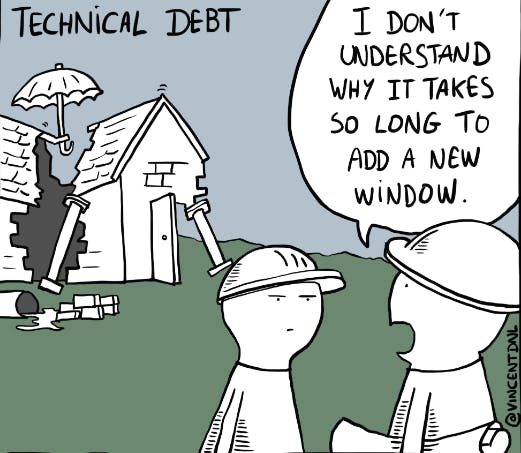
Introduction
"In software development, technical debt (also known as design debt[1] or code debt) is the implied cost of future reworking required when choosing an easy but limited solution instead of a better approach that could take more time.[2]" - wiki
While the definition of technical debt may vary depending on one's role in a software development team, my experience has led me to gain insights and recommendations on how we can manage technical debt effectively. In this blog post, I've shared some of these insights and recommendations, highlighting why it's critical to manage technical debt for the overall health of a project. By implementing strategies to manage technical debt, such as refactoring code, prioritizing high-risk areas, and involving stakeholders in decision-making, software development teams can ensure that their codebase remains healthy and maintainable in the long run.

What is Technical Debt ( Beyond Official Wiki Definition)
Technical debt is the term used to describe the trade-offs that developers make in software development projects between short-term goals and long-term maintainability and extensibility. These trade-offs can lead to the accumulation of technical debt in the codebase, which can make it more difficult and expensive to maintain and extend the software over time.
How does technical debt accumulate?
Technical debt can accumulate in software development projects in a variety of ways, including:
Code duplication: When developers copy and paste code instead of creating reusable functions, it can lead to code duplication and increase technical debt.
Poorly designed or implemented architecture: Poorly designed or implemented software architecture can lead to technical debt by making it difficult to add new features or modify existing ones.
Lack of automated testing: Lack of automated testing can lead to technical debt by making it difficult to find and fix bugs, as well as increasing the risk of introducing new bugs when making changes.
Incomplete documentation: Incomplete or outdated documentation can lead to technical debt by making it difficult for developers to understand the codebase and how different components interact.
Technical decisions based on short-term goals: Technical decisions based on short-term goals, such as meeting a deadline or reducing development costs, can lead to technical debt by sacrificing long-term maintainability and extensibility.
Unmaintainable code: Code that is hard to understand, modify, or extend can accumulate technical debt over time, as developers will need to spend more time understanding and modifying it.
Accumulated technical debt: Over time, technical debt can accumulate in a codebase, making it more difficult and expensive to maintain and extend.
Impact of technical debt
If technical debt is not reduced, it can cause several issues in the software development process and the resulting software product, including:
Increased maintenance costs: Technical debt makes software harder to maintain and change over time, which increases the time and resources required to maintain it.
Reduced software quality: Technical debt often leads to lower-quality software because developers may need to take shortcuts to meet deadlines, which can result in more bugs, lower performance, and reduced functionality.
Higher risk of software failures: Technical debt can increase the risk of software failures, as developers may not fully understand the code they are working on or may introduce new bugs when making changes.
Reduced ability to innovate: Technical debt can limit the ability of developers to innovate and add new features to software because they are spending time maintaining and fixing existing code.
Difficulty attracting and retaining developers: Technical debt can make software development less appealing to developers, as they may be frustrated by the complexity of the code and the amount of time required to maintain it.
If you've read through the previous sections, hopefully you now have a good understanding of what technical debt is, how it accumulates over time in software development projects, and why it's crucial to manage it. However, I understand that some people may still view technical debt as just theoretical jargon that doesn't have much impact in the real world. To help illustrate the significance of technical debt, I'd like to share a couple of real-life examples where it has caused major problems for software development teams.
Healthcare.gov: In 2010, the U.S. government launched the Healthcare.gov website as part of the Affordable Care Act, which aimed to make healthcare more affordable and accessible to Americans. However, when the website launched in 2013, it experienced significant technical problems, including long wait times, error messages, and crashes. It was later discovered that technical debt was a major contributor to these problems, as the website had been developed on a tight deadline with little testing, and with code from multiple vendors that was not well-integrated. This resulted in a highly complex codebase that was difficult to maintain and modify, and that suffered from performance and reliability issues.
Knight Capital Group: In 2012, Knight Capital Group, a financial services firm, experienced a major technical glitch that resulted in the loss of $440 million in just 30 minutes. The glitch was caused by a software update that contained an old, inactive function that had not been removed from the codebase. This function was triggered by the new software update, resulting in a flood of erroneous buy and sell orders that overwhelmed the company's trading system. The incident was attributed to technical debt, as the company had accumulated a significant amount of technical debt over time by making quick fixes and workarounds to address issues, rather than addressing the root causes of problems. This led to a complex and fragile codebase that was difficult to maintain and modify, and that ultimately contributed to the company's financial losses.
Google Bard AI Demo: A recent example of this was Google's AI Bard demo failure, where a software glitch caused the system to malfunction during a live performance. This failure was attributed to shortcuts taken during the development process in order to meet deadlines, which resulted in technical debt accumulating and ultimately causing the system to fail.

How to Mange Technical Debt
It's practically very difficult to avoid tech debt but definitely it can be managed in a better way to keep the project in better health.
Here are some steps you can take to manage technical debt in the software life cycle:
Identify technical debt: Start by identifying technical debt in your codebase. Look for code that is hard to understand or modify, and areas of the codebase that are frequently changed. Use code analysis tools to identify code smells and technical debt hotspots.
Prioritize technical debt: Prioritize technical debt based on its impact on the system and the cost of fixing it. Focus on debt that is most likely to cause issues in the future or that is most expensive to maintain.
Plan for technical debt: Incorporate technical debt management into your project planning. Allocate time and resources to address technical debt as part of each development sprint.
Refactor code: Refactor code to improve its quality and reduce technical debt. Refactoring involves restructuring code without changing its functionality. Use automated refactorings to make the process faster and more reliable.
Use code reviews: Use code reviews to identify technical debt and ensure that new code doesn't add to it. Encourage developers to identify technical debt during code reviews and to suggest ways to address it.
Test code thoroughly: Thoroughly test code to ensure that it meets requirements and doesn't introduce technical debt. Use automated testing to speed up the process and reduce the risk of human error.
Document technical debt: Document technical debt to make it visible to the team. Use a shared document or issue tracking system to track technical debt and its resolution.
Involve stakeholders: Involve stakeholders in technical debt management. Discuss the impact of technical debt on the project schedule and budget, and explain the benefits of addressing technical debt.
Conclusion
Technical debt is a reality of software development that cannot be ignored. It can accumulate over time and cause significant problems, from reduced productivity and quality to increased costs and risks. However, by understanding the causes and effects of technical debt, and taking practical steps to manage and reduce it, software development teams can mitigate these problems and build better, more reliable software. We hope that this blog post has provided some helpful insights and guidance for managing technical debt in your software development projects. Remember, while technical debt may seem like a daunting challenge, with the right mindset and approach, you can tackle it one step at a time and keep your codebase healthy and strong.

Resources
here are some resources that can provide more details on technical debt in case you want to explore it further.
"Managing Technical Debt: Reducing Friction in Software Development" by Philippe Kruchten, Robert Nord, and Ipek Ozkaya: This book provides a comprehensive overview of technical debt and offers practical strategies for managing it in software development projects.
"Refactoring: Improving the Design of Existing Code" by Martin Fowler: This book provides guidance on how to refactor code to reduce technical debt and improve the maintainability and extensibility of software.
"Clean Code: A Handbook of Agile Software Craftsmanship" by Robert C. Martin: This book provides practical guidance on how to write clean, maintainable code that reduces technical debt.
"Technical Debt in Software Development" by Steve McConnell: This article provides an overview of technical debt and offers practical strategies for managing it in software development projects.
"The Technical Debt Quadrant" by Martin Fowler: This article provides a framework for categorizing and prioritizing technical debt based on its impact on the software system and the cost of fixing it.

